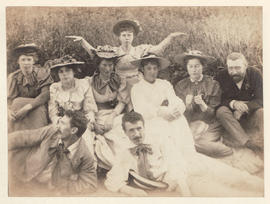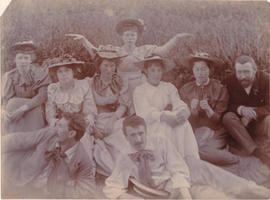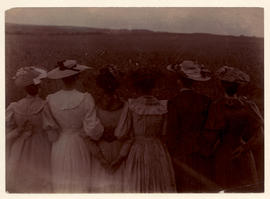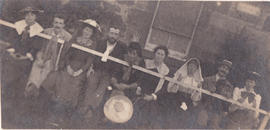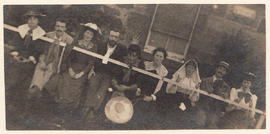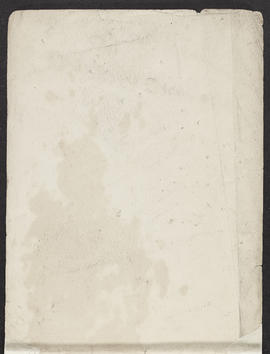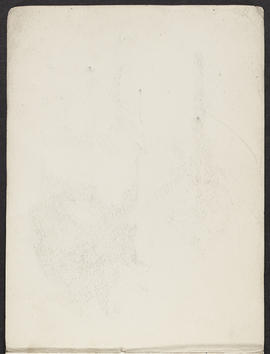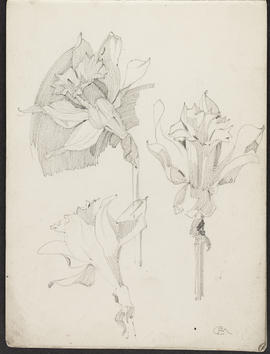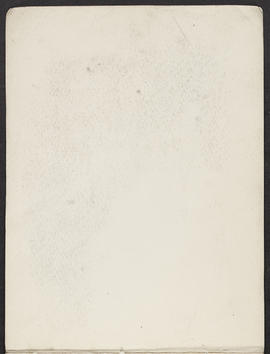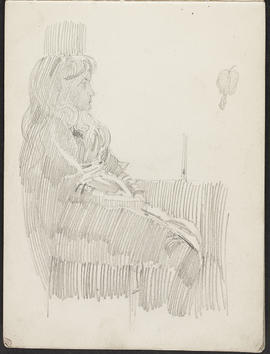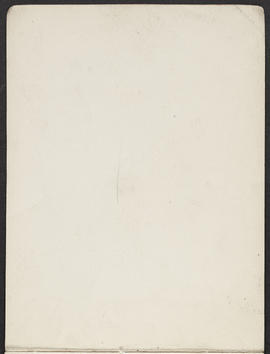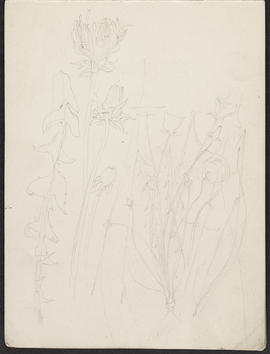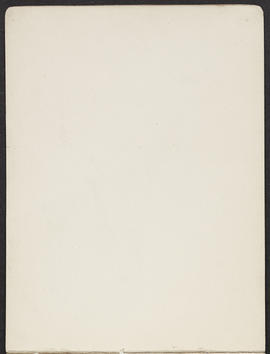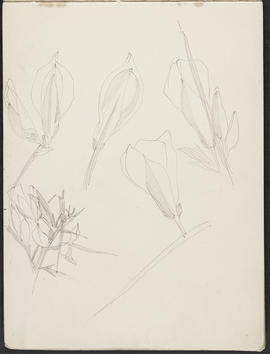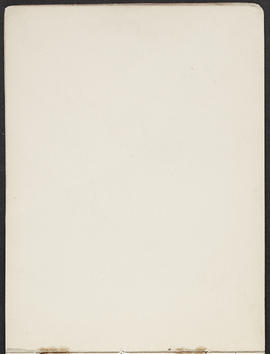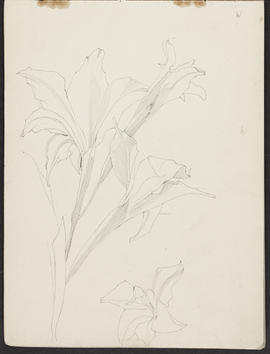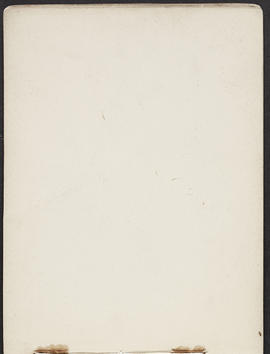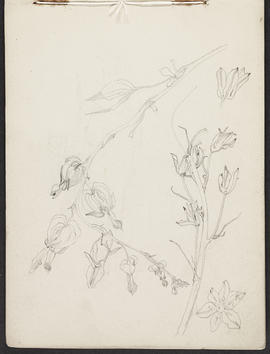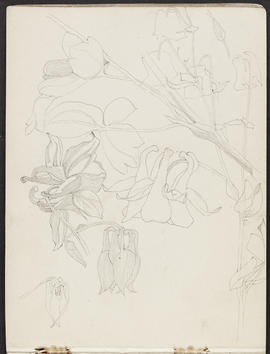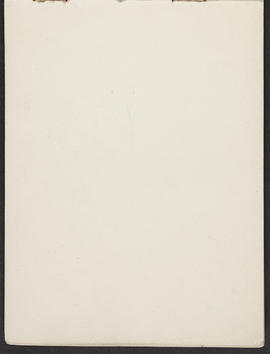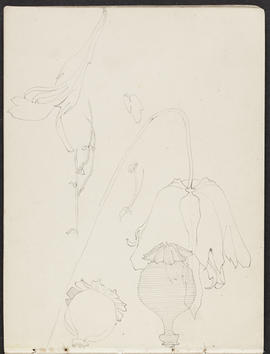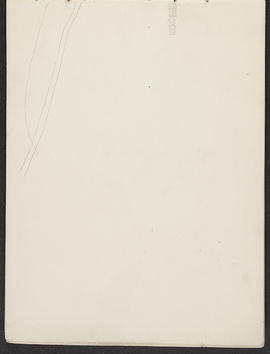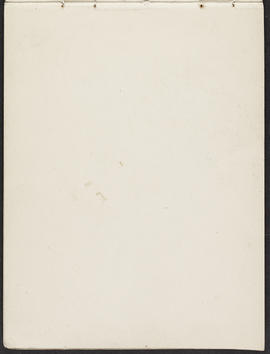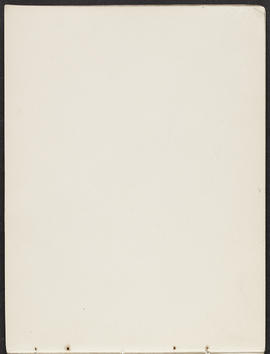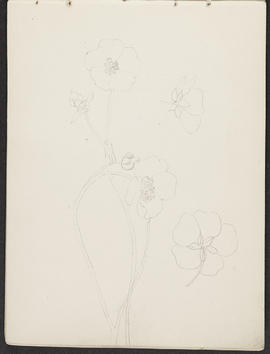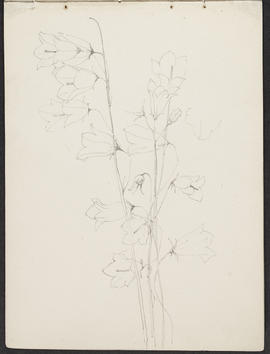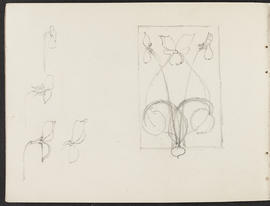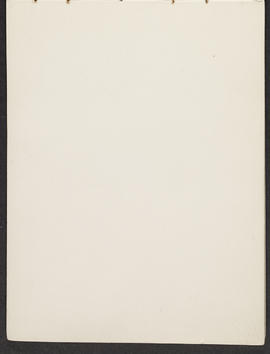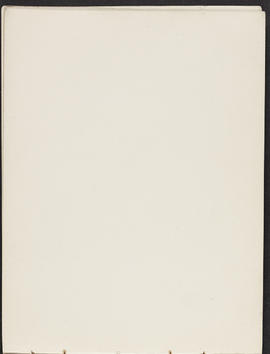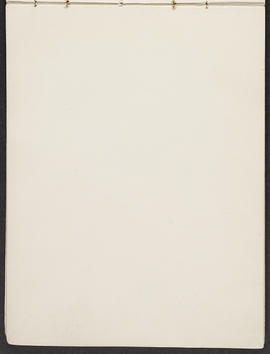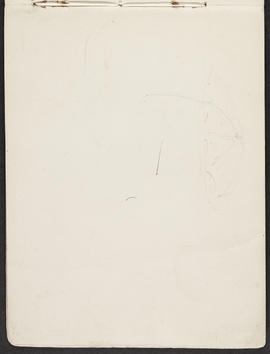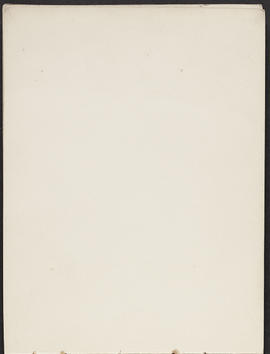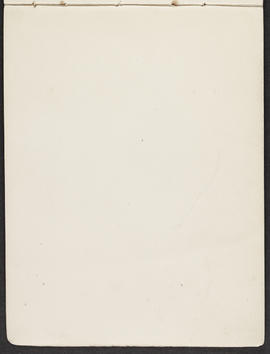Key Information
Reference code
Title
Date(s)
- 1868-1913 (Creation)
Level of description
Collection
Extent
1 Cubic Foot
Content and Structure
Scope and content
Collection includes:
- Menus and dinner invitation to artistic gatherings with a sketch by James E Christie
- London Sketch Club ephemera including menus, invitations, cards with sketches by Shepperson, W Lee Hank, Rene Butt and Jock Bere, 1902-1906
- F. Carruthers Gould ephemera containing invites to private views
- tudies for Pictures by J Moyr Smith, 1868
- Information on John Burnet, Architect, 1814-1901
- Photograph album, c1893
The photograph album contains photographs of "The Immortals", including Jessie Keppie, Charles Rennie Mackintosh, Herbert MacNair, Frances Macdonald, Margaret Macdonald and others of their circle.
The Moyr Smith sketches are from Moyr Smith's first published book Studies in Pictures. Smith trained in Glasgow, becoming influenced by Alexander Thomson and Daniel Cottier, moving to London in 1864.
Of great importance in this collection is a sketchbook of drawings by Charles Rennie Mackintosh. The sketchbook, dating from the 1890s, consists of 19 drawings of flowers, furniture sketches, and interior sketches of Craigie Hall, Pollokshields, Glasgow.
Appraisal, destruction and scheduling
This material has been appraised in line with Glasgow School of Art Archives and Collections standard procedures.
Accruals
System of arrangement
The arrangement of the material reflects the order in which it was deposited.
General Information
Name of creator
Biographical history
Jessie Keppie was the youngest sister of John Keppie, architect. She studied at the Glasgow School of Art between 1888-1899 under Fra Newbery and James Dunlop. She worked in watercolours, painting landscapes and flowers in a 'wet' manner, probably influenced by Arthur Melville.
Name of creator
Biographical history
James Elder Christie was a portrait and genre painter. Christie received his artistic training at art school in Paisley and South Kensington. He became known for his portraits, paintings of children, moral allegories and illustrations to the poetry of Robert Burns. He won two gold medals at the Royal Academy in 1876 and 1877. In the 1870s Christie attended life classes in M. Barthe's studio in Limerston Street, in Chelsea, classes which Whistler also attended at this time. On 9 November 1882 he was elected an artist member of Glasgow Art Club, resigned on 15 February 1889. In 1893 he moved back to Glasgow, and was re-elected to the Club on 20 December 1894, and finally elected as an honorary member on 29 December 1913. Following a period in Paris, Christie joined the New English Art Club.
Name of creator
Biographical history
Francis Carruthers Gould (2 December 1844 - 1925), British caricaturist and political cartoonist, was born in Barnstaple, Devon. He published as F. Carruthers Gould and signed his cartoons FCG.
Although in early youth he showed great love of drawing, he began life in a bank and then joined the London Stock Exchange, where he constantly sketched the members and illustrated important events in the financial world; many of these drawings were reproduced by lithography and published for private circulation. In 1879 he began the regular illustration of the Christmas numbers of Truth, and in 1887 he became a contributor to the Pall Mall Gazette, transferring his allegiance to the Westminster Gazette on its foundation and subsequently acting as assistant editor.
Among his independent publications are Who killed Cock Robin? (1897), Tales told in the Zoo (1900), two volumes of Froissart's Modern Chronicles, told and pictured by FC Gould (1902 and 1903), and Picture Politics—a periodical reprint of his Westminster Gazette cartoons, one of the most noteworthy implements of political warfare in the armoury of the Liberal Party. With Sir Wilfrid Lawson he published Cartoons in Rhyme and Line (1905). Frequently grafting his ideas onto subjects taken freely from Uncle Remus, Alice's Adventures in Wonderland, and the works of Dickens and Shakespeare, Gould used these literary vehicles with extraordinary dexterity and point, but with a satire that was not unkind and with a vigour from which bitterness, virulence and cynicism were notably absent. He was knighted in 1906. Unpublished manuscripts and biographical material are in the House of Commons Library historical collections, kept in the House of Lords Record Office. Carruthers Gould was responsible for designing 11 Toby jugs of World War I political and military figures between 1915 and 1920.
Name of creator
Biographical history
John Hassall (21 May 1868, died 8 March 1948) was an English illustrator, known for his advertisements and poster designs. Hassall was born in Walmer, Kent, and was educated in Worthing, at Newton Abbot College and at Neuenheim College, Heidelberg. After twice failing entry to The Royal Military Academy Sandhurst, he emigrated to Manitoba in Canada in 1888 to begin farming with his brother Owen. He returned to London two years later when he had drawings accepted by the Graphic. At the suggestion of Dudley Hardy (along with Cecil Aldin, a lifelong friend), he studied art in Antwerp and Paris. During this time he was influenced by the famous poster artist Alphonse Mucha. In 1895, he began work as an advertising artist for David Allen & Sons, a career which lasted fifty years and included such well-known projects as the poster "Skegness Is so Bracing" (1908). Between 1896 and 1899 alone, he produced over 600 theatre poster designs for this firm while, at the same time, providing illustrations to several illustrated newspapers. Making use of flat colours enclosed by thick black lines, his poster style was very suitable for children's books, and he produced many volumes of nursery rhymes and fairy stories, now fetching high prices on eBay, such as Mother Goose’s Nursery Rhymes (1909). In 1901, Hassall was elected to the membership of the Royal Institute of Painters in Water Colours and the Royal Society of Miniature Painters. He also belonged to several clubs, including the Langham (until 1898), the Savage, and perhaps most notably, the London Sketch Club (of which he was a President 1903-4). In 1900, Hassall opened his own New Art School and School of Poster Design in Kensington where he numbered Bert Thomas, Bruce Bairnsfather, H. M. Bateman and Harry Rountree among his students. The school was closed at the outbreak of the First World War. In the post-war period, he ran the very successful John Hassall Correspondence School. John Hassall was the father of poet Christopher Hassall and the printmaker Joan Hassall, OBE. He was also the grandfather of the actress Imogen Hassall and grandfather (and surrogate father) to noted "green" architect, David Dobereiner. Arguably John Hassall's most famous creation was "the Jolly Fisherman" in 1908, which is regarded as one of the most famous holiday advertisements of all time. His 1910 design for the Kodak Girl, in her iconic striped blue and white dress, became a feature of Kodak's advertising to the 1970s. Hassall's design was continually updated to reflect changing fashions and trends and was longer lasting and of greater international significance than his Jolly Fisherman.
Name of creator
Biographical history
By the end of the 19th century Glasgow School of Art was one of the leading art academies in Europe and after early success in the fine arts, the late 1890s saw Glasgow’s reputation in architecture and the decorative arts reach an all time high. At the very heart of this success was a talented young architect and designer, Charles Rennie Mackintosh whose reputation was to quickly spread beyond his native city and who, over a century later, is still regarded as the father of Glasgow Style.
Born in Glasgow on 7 June 1868, Mackintosh was apprenticed to a local architect John Hutchison, but in 1889 he transferred to the larger, more established city practice of Honeyman and Keppie.
To complement his architectural apprenticeship, Mackintosh enrolled for evening classes at the Glasgow School of Art where he pursued various drawing programmes. Here under the watchful eye of the headmaster Francis Newbery, his talents flourished and in the School’s library he was able to consult the latest architecture and design journals becoming increasingly aware of his contemporaries both at home and abroad. He won numerous student prizes and competitions including the prestigious Alexander Thomson Travelling Studentship in 1890 that allowed him to undertake an architectural tour of Italy.
Back in Glasgow, Mackintosh’s projects for Honeyman and Keppie during the early 1890s displayed an increased maturity. His design for the Glasgow Herald Building (1894) incorporated some cutting-edge technology including a hydro-pneumatic lift and fire-resistant diatomite concrete flooring. Later at Martyr’s Public School (1895), despite a somewhat restricted brief, he was able to introduce some elaborate but controlled detailing including the central roof trusses.
At a public lecture on architecture in 1893, Mackintosh argued that architects and designers be given greater artistic freedom and independence. He himself began to experiment with a range of decorative forms, producing designs for furniture, metalwork and the graphic arts (including highly stylised posters and watercolours), often in partnership with his friend and colleague at Honeyman and Keppie, Herbert MacNair and two fellow students, Margaret and Frances Macdonald.
In 1896 Mackintosh gained his most substantial commission, to design a new building for the Glasgow School of Art. This was to be his masterwork. Significantly, the building was constructed in two distinct phases, 1897-99 and 1907-09, due to a lack of money. Stylistically, the substantial delay in completion offered Mackintosh the opportunity to amend and fully integrate his original design (of 1896) which owed much to Scotland’s earlier baronial tradition with a second half to the building that looked very much to the 20th century through its use of materials and technology. Most dramatic of all the interiors was the new Library (completed in 1909), which was a complex space of timber posts and beams. Its construction owed much to traditional Japanese domestic interiors but ultimately the building was an eclectic mix of styles and influences.
In Europe the originality of Mackintosh’s style was quickly appreciated and in Germany, and particularly in Austria, he received the acclaim and recognition for his designs that he was never truly to gain at home. He contributed to the 8th Vienna Secession and participated in international exhibitions in Turin, Moscow and elsewhere. He entered an open competition to design ‘A House for an Art Lover’, put forward by a German design journal, Zeitschrift fur Innendekoration, in 1900. Although he failed to win the competition, his architectural designs were judged to be of such a high standard that they were later reproduced as a portfolio of prints.
Back in Scotland at The Hill House in Helensburgh (1904), the publisher Walter Blackie commissioned Mackintosh to design a substantial family home. In its appearance, it owed much to his House for an Art Lover designs and an earlier completed domestic commission, Windyhill (1900). Externally, The Hill House was notable for its simple and solid massed forms with little ornamentation, yet internally the rooms exuded light and space, and the use of colour and decoration was carefully conceived.
Throughout his career Mackintosh relied on just a handful of patrons and supporters. The Glasgow businesswoman Catherine Cranston proved to be one of his most influential and her series of tearoom interiors (designed and furnished between 1896-1917) provided him with a virtual freedom to experiment. Responsible for their ‘total design’ Mackintosh provided the tearooms with furniture (including the dramatic high-back chairs), light fittings, wall decorations and even the cutlery.
Despite success in Europe and the support of clients such as Blackie and Cranston, Mackintosh’s work met with considerable indifference at home and his career soon declined. Few private clients were sufficiently sympathetic to want his ‘total design’ of house and interior. He entered the competition to design a cathedral for the City of Liverpool (1902) but although his design showed a Gothic quality as requested, his entry was rejected and his design for Scotland Street School (1906) in Glasgow was to be his last public commission.
By 1914 Mackintosh had despaired of ever receiving the level of recognition in Glasgow that he felt he deserved. He became increasingly obstinate and incapable of compromise and it is known that this exerted unnecessary pressures on his colleagues. In an attempt to resurrect his career, Mackintosh resigned from the practice and with his wife Margaret Macdonald moved to London.
This was unfortunate timing, for with the onset of the First World War all building work was severely restricted. Adventurous plans for a suite of artists’ studios and a theatre were never built. However, after making adjustments to the exterior of a mid-terraced house at 78 Derngate in Northampton (1916), the client W J Bassett-Lowke commissioned Mackintosh to redecorate a number of the building’s interiors including the Guests’ Bedroom (1919). These designs show him working in a bold new style of decoration and construction, using primary colours and geometric motifs. It was an output of extraordinary vitality and originality but it went virtually unheeded.
A move to the South of France in 1923 signalled the end of Mackintosh’s three-dimensional career and the last years of his life were spent painting. He died in London on 10 December 1928.
Name of creator
Biographical history
John Moyr Smith was born in Glasgow as John Smith on 12 March 1839, the son of David Smith, wine and spirit merchant, and his wife Margaret Moire. Some sources state that the family came from northern England but his mother came from Kirkaldy (not traced), Doune, Perthshire. He appears to have been articled to James Salmon c.1855-59, thereafter working as an assistant for James Smith on Overtoun House, Dumbarton, along with William Scott Morton. During those years he adopted the middle name of Moir, later spelled Moyr, attended Glasgow School of Art from November 1857 and became president of the Glasgow Architectural (Assistants) Association of which Robert Grieve Melvin was treasurer. By his own account he was wholly responsible for Smith's Stirling's Library until December 1863 when Smith died and Melvin and his partner William Leiper took over the project. During his time on the Overtoun and Stirling's Library projects Moyr Smith became a member of Alexander Thomson's circle - which at that date included Leiper, Bruce Talbert, and Daniel Cottier - and began developing an interest in painting and the decorative arts: he was presumably the J M Smith at 295 Hope Street who exhibited 'Vivien tempting King Arthur' at the Glasgow Institute in 1862. The catalogue records that it had been acquired by Robert Dalglish MP. Moyr Smith probably remained with Melvin until the Stirling's Library project was nearly complete, but sometime before 1864 he moved to Manchester as assistant to the gothicist Alfred Darbyshire with whom he remained for three years. It was probably during this period that Smith first became acquainted with the artist and designer Henry Stacey Marks. In 1866 Moyr Smith moved to London as assistant to George Gilbert Scott, but by that date he had already established a reputation as an illustrator in Tom Hood's 'Fun' magazine and by about 1867 he had commenced 'temporary service' for Christopher Dresser and begun supplying designs to the Arthur Silver Studio. Moyr Smith's first book, 'Studies for Pictures: A Medley' (1868), was dedicated to Dresser, and in the following year, 1869, he visited Gustave Doré in Paris, probably with a view to furthering his career as an illustrator. In 1868 Moyr Smith was commissioned to make designs for furniture and fittings for the Building News and by about 1872 he established a career as a chromo-lithograph illustrator, some of his biblical scenes having markedly Thomsonesque detail. He also made designs for Bruce Talbert's studio although the relationship between their practices has not been precisely established. From 1880 he was editor of the magazine 'Decoration in painting, sculpture, architecture and art manufactures' published by Sampson Low. From about 1870 Moyr Smith had an extensive commercial practice in the decorative arts, his main clients being the cabinetmakers Collinson & Lock and Cox & Son, the piano-maker Broadwood & Son and the tile and ceramic manufacturers Minton & Co (later Minton Hollins & Co), W B Simpson & Sons, and Maw & Co. He also undertook decorative schemes, not merely in Britain but also in the USA, the most ambitious of these being the Holloway Sanatorium, Virginia Water, in 1877-78. Some of these were undertaken in association with John Gregory Crace and John Dibblee Crace. It is probable that some of his clients for such work were Scottish, but no work in Scotland has as yet been traced. In person Moyr Smith was tall, bearded and red-haired, and according to D S McColl 'fiery in temperament'. He appears to have worked alone without staff. He never married, and in his earlier London years his household was managed by his mother and unmarried sister Christina. Initially they lived at Walham Grove, Putney, but in 1873-74 Moyr Smith designed and built a large studio house, Doune Lodge, in Oxford Road, Putney, which had notable interiorwork. By 1891 he was living alone and in 1894 he moved to a smaller house, Bloomfield in Queen's Road, Richmond. In these later years he renewed his links with the Ferguson family in Lenzie and bought Oakbank Cottage, Kilcreggan where he died on 1 December 1912. Moyr Smith published four important books: 'Studies for Pictures: A Medley' (1868); 'Album of Decorative Figures' (1882); 'Ancient Greek Female Costume' (1882); and 'Ornamental Interiors, Ancient and Modern' (1888). He also illustrated a great many others: a comprehensive list is given in Stapleton.
Archival history
Custodial history
Unknown.
Physical Description and Conditions of Use
Conditions governing access
Glasgow School of Art Archives and Collections are open for research by appointment. For further details, please refer to our Access Policy @ https://gsaarchives.net/policies
Conditions governing reproduction
Application for permission to reproduce should be submitted to The Archives and Collections at The Glasgow School of Art.
Reproduction subject to usual conditions: educational use and condition of material.
For further details, please refer to our Reprographic Service Guide @ https://gsaarchives.net/policies
Language of material
- English
Script of material
Language and script notes
Physical Description
There are no physical characteristics which affect the use of this material.
Finding aids
Related Material
Existence and location of originals
Existence and location of copies
No known copies.
Related materials
Notes area
Note
Collection Historical Note
Jessie Keppie was the youngest sister of John Keppie, architect. She studied at the Glasgow School of Art between 1888-1899 under Fra Newbery and James Dunlop. She worked in watercolours, painting landscapes and flowers in a 'wet' manner, probably influenced by Arthur Melville.
Alternative identifier(s)
Keywords/Tags
Place access points
People and Organisations
- The Glasgow School of Art (Subject)
- MacNair, Frances Macdonald (Subject)
- MacNair, James Herbert (Subject)
- Mackintosh, Charles Rennie (Subject)
- Mackintosh, Margaret Macdonald (Subject)
Genre access points
Status
Level of detail
Processing information
- Fonds level description compiled by Adele Ashley-Smith, Archivist, 2000-2001
- Updated by David Powell, Hub Project Archivist, 5 November 2001
- Updated by David Powell, Hub Project Archivist, 14 May 2002
- Fonds level description imported from the Archives Hub 23 August 2006
- Updated by Kimberly Sommerville, GSA Archives Assistant, 4 November 2010
- Catalogue imported into Archon software and edited by Michelle Kaye, Archon Project Officer, May 2014.
- Catalogue exported from Archon and imported into AtoM during system migration, 2018-2019.
Language(s)
- English
Script(s)
Sources
Archivist's note
Finding Aid Authors: The Glasgow School of Art Archives and Collections.
Archivist's note
© Copyright 2014 GSA Archives. All rights reserved.



